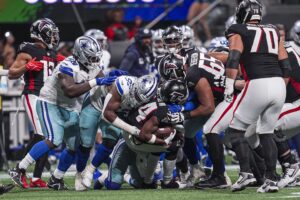At the time of writing, it’s already old news that the Green Bay Packers have submitted a bid to host the NFL Draft in either 2019, 2020 or 2021. Packer fans are excited, but the team cautions that this might be a hard sell. Teams like to host events like the Draft to generate economic impact and be able to compete. Cities are happy for the positive economic impact a Draft would bring, especially long term ones.
It’d be nice to see Green Bay host this event in 2019, 100 years after the team was first established. The Packers can point to their team and league history, and new construction in their application. Lambeau Field was upgraded in 2013, and is ready to be shown off, and the adjacent Titletown District will also provide a draw. Now is a good time but can a Green Bay NFL Draft bid compete with other cities?
Why a Green Bay NFL Draft Makes Sense
Why Do the Fans Want to be There?
Economists classify the NFL Draft as a mega event. Hosting one is touted as a boon for the host city. The draft, you may recall, was held in New York for 50 years. In 2015 and 2016, however, it was brought to Chicago. This year, it’s Philadelphia’s turn to play host to a star studded roster. It will include 22 prospects, including Deshaun Watson and Jonathan Allen, along with 13 NCAA head coaches.
There’s excitement in the air and promises of new futures for players. Maybe you’ll catch a glimpse of someone you look up to as a player or a coach. And that’s why fans attend the draft. It’s a chance to see the stars of the future, visit a stadium, and hang with other football nerds. And they come from all over, not just from the host city. Their spending is considered new spending; exactly what host cities are after.
Titletown: It’s All About Football!
Green Bay hosts the National Railroad Museum, a botanical garden, and several historic sites. Football, however, seems to be what brings the tourists in the first place. Those visitors then add the other activities to their schedule. According to numbers released at the Packers’ 2016 shareholders meeting, 175,000 fans took stadium tours in 2015 alone. Since then, numbers have grown even higher. Other activities for tourists also cater to these football fans. You can, for example, visit the mile-long Walk of Legends, or explore the Packers Heritage Trail – it’s all about football. All this should make Green Bay a shoe-in in the race to host a Draft. Still, winning the pitch to host the draft can be a hard sell for Green Bay. The league is likely more interested in revenue generation and the economic impact of the event than in the historic impact of the team.
The Metrics of the Draft
When organizers try to estimate the economic impact of a mega event, they use industry standard event calculators. These take into account the type of data you just read and cross reference it with local taxes and similar metrics. Because Chicago reported an economic impact of $81.6 million, Philly will expect roughly $80 million of the same. Note, however, that Choose Chicago, the city’s non-profit tourism body, never said that the city “made” $81.6 million from the draft. Rather, they said the draft could provide $81.6 million of residual benefit to the City. But as with any mega event, there are pros and cons to hosting one. Hosting such a large event is taxing on any city, both in terms of cost and mental effort. The smaller the place, the more taxing. And Green Bay is the smallest market in the league.
Costs to Compete
Cities understand that hosting mega events will cost them. They also understand that much of the funding will have to come from the public purse. For example, hosting a Super Bowl may entail constructing a new stadium and improving transit to the venue. A new interchange may have to be constructed to handle automobile traffic. Security costs are significant, as is policing, transportation, communication, and accommodation, and not just to the host city. Surrounding areas also have to buck up to cover expenses in conjunction with mega events. The idea is that the event will stimulate the host city’s economy and promote the city’s brand. Theoretically, this should ensure that the monies spent are recuperated during and after the event. Sometimes that doesn’t happen, though. Case in point: Chicago was still on the hook for $350,000 six months after the draft.
Is Green Bay Ready?
Host cities have to factor in the new construction that generally goes hand in hand with NFL mega events. But little new construction should not be necessary in Green Bay with the new Titletown District. And, unlike a new stadium, it won’t be funded by the city. New roads and other infrastructure to accommodate it will be, but not because of the Draft. That infrastructure was already necessary to facilitate the construction of the District itself. The Lambeau Field expansion is completed, and was funded by the team. While it is unlikely that the draft would create many permanent new jobs for the community, the opportunity for exposure for the city is huge. Chicago reported $114.7 million in established TV and Digital Media ad value from their kick at the can. Altogether, 8.8 million people watched Chicago’s first round draft on TV.
Chicago by the Numbers
Of course, the bigger the event, the more likely it is to stimulate the host city’s economy. As a result, more than half of the NFL’s cities have said they’d like to host an NFL mega event. When Chicago hosted the draft, it was held in the Auditorium Theatre at Roosevelt University. The actual draft went hand in hand with a free fan festival, “Draft Town,” held in Grant Park. Following the event, Choose Chicago released their numbers. It should be noted here that interpreting economic impact is a rather tricky business. On the other hand, claims of visitor numbers etc. are fairly straight forward. 200,000 people visited Draft Town. Of these, over 1,000 were school students visiting from ten public schools. The draft generated 36,576 hotel nights in Chicago and $456,000 in city hotel tax revenue.
The Balancing Act
According to Choose Chicago, nearly half of attendees were from outside of Chicago. As previously mentioned, new spending is always an important factor in that positive economic impact cities are striving for. In making its decision on awarding the Draft to a particular city, it’s exactly what the NFL wants to see. This is also the number that is of interest to the host city. It’s the one that must offset the cost of hosting. In the smallest market in the league, a larger percentage of attendees are out-of-towners (relative to bigger markets, like Chicago, Philadelphia and New York). So the draft’s economic impact to the overall economy may be more noticeable in Green Bay than elsewhere. Moreover, Green Bay’s tourism stems mainly from football. Ergo, it is unlikely that draft visitors would displace other tourists – always a problematic issue in other host cities.
The Potential for Options
We all know that Packer Backers will brave snow and sleet to attend a home game. But will potential draft spectators – non-Cheeseheads – think that Lambeau Field in April is a great idea? It has been suggested that the Resch Center, across the street from Lambeau Field, could be used instead. The Center, which seats 10,000 people, is close to the Titletown District and Lambeau Field. This obviously makes for little need for updates to transportation, thus constituting a considerable savings to the organizers. Investors expect the new 35-acre Titletown District to be open for business soon. It will reportedly include a Lodge Kohler hotel, Hinterland Brewery, a Bellin Health Clinic and a public park and plaza. This effectively ensures that out of town visitors will have options for accommodation, a choice of places to eat, and a place to play.
So, Can Green Bay Compete?
Green Bay seems to have positioned itself well to host a draft. The NFL may not see it that way, though. The team has said it will be a hard sell, and they should know. It is likely that there will be some back and forth on this from a negotiating standpoint. Either way, there’s little doubt that if it goes ahead, the community of Green Bay will put it’s best foot forward. Some would say this is a great opportunity for Green Bay fans to show what they’re made of, too. Whichever way the chips fall, it’ll be interesting to follow this story and see how it plays out.






